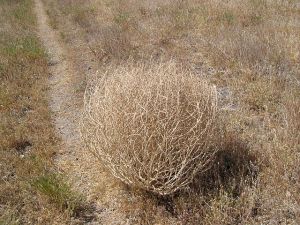I’ll keep rolling along
Deep in my heart there’s a song
Here on the range I belong
Drifting along with the tumbling tumbleweeds
- Bob Nolan “Tumbling Tumbleweeds” (1935)
When this song was sung by the Sons of the Pioneers (featuring Roy Rogers) in the middle of the Depression, the plant to which the name usually refers, Kali tragus or Russian thistle, had been present on this continent for about 60 years. It is generally agreed that it arrived in South Dakota in 1873 mixed with flax seed sent from the Ukraine. It spread across the west rapidly because it thrives on disturbed landscapes such as those that are denuded of other vegetation by overgrazing, farming, and erosion of the topsoil.

Although K. tragus is the most common plant referred to as “tumbleweed,” this word actually refers to a number of unrelated species that use this mode of seed distribution. In all of these plants the branches and leaves die and only the seeds remain alive. The dead plant is detached from its roots by the wind and sent rolling across the land. The seeds—which number 150,000 to 250,00 per plant—are shaken loose by the motion. They germinate when conditions are right for their survival.
This mode of distribution is found among ruderal plants, which are the first to colonize unvegetated surfaces. These “pioneer communities” are generally replaced by the next sere after they manage to trap enough organic matter to allow different plant species to germinate. In some cases where the conditions are extreme, in alkaline soils for example, the pioneer community may persist indefinitely. K. tragus was formerly included in the genus Salsola, which is derived from the Latin sallere, “to salt.”
 The classification of this plant is apparently in flux. The genus Salsola, where it resided for many years (Linnaeus put it there), was subjected to DNA analysis in 2007 and some species, including tragus, were reassigned. These genera were once thought to be part of the Chenopodiaceae, but that family has now been folded into the Amaranthaceae. Some sources call it Salsola kali, but this would seem to be the older name for a coastal species now called Kali turgida and native to the Baltic and North seas and the shores of the Atlantic in northern Europe. Some systematists call the Kali species a “species aggregate,” a group of very closely related species and suggest that the seed mixed in with the Russian flax seed in the 1870s may have been a mix of several subspecies or species.
The classification of this plant is apparently in flux. The genus Salsola, where it resided for many years (Linnaeus put it there), was subjected to DNA analysis in 2007 and some species, including tragus, were reassigned. These genera were once thought to be part of the Chenopodiaceae, but that family has now been folded into the Amaranthaceae. Some sources call it Salsola kali, but this would seem to be the older name for a coastal species now called Kali turgida and native to the Baltic and North seas and the shores of the Atlantic in northern Europe. Some systematists call the Kali species a “species aggregate,” a group of very closely related species and suggest that the seed mixed in with the Russian flax seed in the 1870s may have been a mix of several subspecies or species.

K. tragus begins life as a bright green, grass-like shoot. It rapidly reaches three feet in height and will continue growing while there is enough moisture for it to do so. The stems turn red or a striped purple and the small whitish flowers appear in the axils between branches. The inflorescences have no petals but broad sepals instead.
Before it flowers K. tragus is succulent and is browsed by many wild animals including bighorn sheep, pronghorn and mule deer. Although it is generally reviled by ranchers and farmers, during the Dust Bowl of the 1930s it was fed to beef cattle when drought caused the hay crops to fail. The seeds are eaten by small mammals and birds.
K. tragus is difficult to get rid of if your land use continually disturbs the soil. Although several websites still recommend various herbicides, there are some that urge against them as not worth the effort and some that admit that herbicide-resistant biotypes exist. In one fascinating account a Forest Service paper declares that it there is still topsoil present at a site, then it is better to let the Russian thistle remain because the mycorrhizal fungi in the soil would stunt or kill the ruderal plant. It then serves as mulch for other plants and even shelter for their seeds. In the absence of topsoil it is better to add it than to try to kill the K. tragus.

You must be logged in to post a comment.